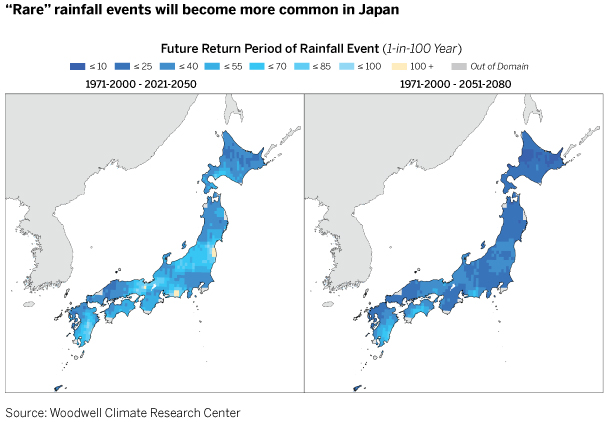Tracing our history to 1928, Wellington Management is one of the largest independent investment management firms in the world. We serve as a trusted adviser for institutions in more than 60 countries.
Japan rises to the challenge of climate change
The views expressed are those of the authors at the time of writing. Other teams may hold different views and make different investment decisions. The value of your investment may become worth more or less than at the time of original investment. While any third-party data used is considered reliable, its accuracy is not guaranteed. For professional, institutional, or accredited investors only.
By: Alan Hsu, Global Industry Analyst; Chris Goolgasian, CFA, CPA, CAIA, Director of Climate Research
Like many countries, Japan is facing advancing risks of climate change. Our research with Woodwell Climate Research Center indicates that the country will experience more periods of extreme heat and greater probability of flooding from heavy rainfall events, coastal storms, and sea-level rise. As climate change increases the risk of devastating consequences, companies developing solutions to help prepare and protect society should see expanding markets and growing demand.
Extreme heat
Woodwell projects the risk of dangerous heat will double in southern Japan by 2050, while northern regions may experience at least 20 days of extreme heat per year ( Figure 1 ). Japan’s aging population is vulnerable to heat-related illnesses such as exhaustion and stroke. Heat can also lead to higher hospitalization rates, workforce health risks, and lower productivity.
FIGURE 1
Flooding
Japan faces a triple threat of flooding: deluge following heavy rainfall, storm surge from typhoons, and inundation from rising sea levels. The probability of extreme rainfall events in Japan is increasing.
According to Woodwell, a historical 100-year precipitation event will be twice as likely by 2035 and four time as likely by 2065 for most of Japan. 1 In northern Japan, a historical 1-in-100-year rainfall event will become a 1-in-10-year event ( Figure 2 ). The country’s topography features a very steep slope from the central mountains to the coastal plain, which causes high river-flow rates and exacerbates flood risk.
Japan has historically been proactive in building and upgrading infrastructure to improve resilience against natural disasters, including earthquakes and flooding. To bolster flood defenses, Tokyo officials pioneered the idea of “super levees,” completing construction on the first embankment in 2013. At nearly 300 meters wide, Japan’s super levees reduce the risk of river-bank breaches and are resistant to liquefaction during earthquakes. Tokyo also built a US$13 billion underground urban rainfall storage and pump system for periods of heavy precipitation. Despite these impressive efforts, however, Japan will likely need additional adaptation investment, given projections for worsening climate conditions.
FIGURE 2
Japan is also vulnerable to typhoons, which bring storm surge along with strong winds and torrential downpours. While Japan’s infrastructure is generally well-protected against typhoons, given the advancing threat of climate change, the government is reassessing...




